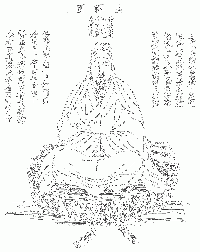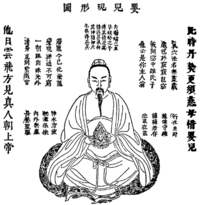The Secret of the Golden Flower
| Part of a series on Taoism | |
|
Fundamentals | |
|
Prominent Taoists | |
|
Deities and Immortals | |
|
Main Sects | |
|
Taoist Texts | |
|
Taoist Precepts | |
|
Sacred Sites | |
|
Portal:Taoism | |
The Secret of the Golden Flower ("Tai Yi Jin Hua Zong Zhi",《太乙金華宗旨》), a Chinese book about meditation, was translated by Richard Wilhelm (also translator, in the 1920s, of the Chinese philosophical classic the I Ching). Wilhelm, a friend of Carl Jung, was German, and his translations from Chinese to German were later translated to English by Cary F. Baynes. According to Wilhelm, Lü Dongbin was the main originator of the material presented in the book. More recently (1991), the same work has been translated by Thomas Cleary, a scholar of Eastern studies.
Translations
There are significant differences between the Wilhelm and Cleary translations. Wilhelm was introduced to the work by his Chinese teacher[1], while Cleary, as an accomplished scholar, arrived at his own translation and interpretation.
Classic works of Chinese philosophy preserve a spectrum of pre-modern science, from a time when philosophy and science were less distinct.[2] The foundations of their teachings often do not comport with modern science, yet the teachings are of significant efficacy in providing a degree of awareness that might otherwise remain obscured by modern society’s attention to more stringent standards of rational thought (for a further discussion of possible benefits, see Meditation). To use Chinese terms, these philosophical works include yin thought with yang thought, that is, they reflect intuitive as well as rational perception. Intuitive perception accumulates and improves with practice and time. Rational thought benefits from an enhanced acuity of intuitive perception.
Wilhelm's translation resulted from his presence in China, where he learned classical philosophy from a Chinese sage. In the sense of conveying impressions received from his teacher, Wilhelm's work tends to portray the more yin aspect of The Secret of the Golden Flower, while Cleary's is a more scholarly, yang, translation. Jung provides comments for both of Wilhelm's major Chinese translations, including (in 1949) the nineteen-page (pp. xxi-xxxix) Foreword to the Wilhelm/Baynes translation of the I Ching, augmenting the philosophical aspect. Cleary takes several opportunities to criticize the validity of Wilhelm's translation.
Like the story of blind people describing an elephant, it seems the poetic aspect of Chinese philosophy communicates an imagery that serves to inform and confirm practitioners according to their own predispositions. The poetic imagery essentially conveys ideas and perceptions better suited to imagining than reasoning, with the hope that in time a convergence of imagery and reason will take place in a manner that is informative.
Contents
Despite the varieties of impressions, interpretation and opinion expressed by Wilhelm, Jung and Cleary, the meditation technique described by The Secret of the Golden Flower is a straightforward, silent technique (the book's description of meditation has been characterized as 'Zen with details'). The meditation technique, set forth in poetic language, reduces to a formula of sitting, breathing and contemplating. Sitting primarily relates to a straight posture. Breathing is described in detail, primarily in terms of the esoteric physiology of the path of qi (also known as chi or ki), or breath energy. The energy path associated with breathing has been described as similar to an internal wheel vertically aligned with the spine. When breathing is steady, the wheel turns forward, with breath energy rising in back and descending in front. Bad breathing habits (or bad posture, or even bad thoughts) can cause the wheel not to turn, or move backward, inhibiting the circulation of essential breath energy. In contemplation, one watches thoughts as they arise and recede.
A minimum of fifteen minutes of meditation practice per day is recommended. After one hundred days, one should begin to get a feel for the method. The meditation technique is supplemented by descriptions of affirmations of progress in the course of a daily practice, suggesting stages that could be reached and phenomenon that may be observed such as a feeling of lightness, like floating upward. Such benefits are ascribed to improved internal energy associated with breath energy circulation, improvements that alleviate previously existing impediments. Several drawings portray imagery relevant to the personal evolution of a meditation practitioner, images that may be somewhat confusing in terms of pure rational analysis. The first such illustration represents the first one hundred days, or gathering the light. Stage 2 represents an emergence of meditative consciousness. Stage 3 represents a meditative awareness that exists even in mundane, daily life. Stage 4 represents a higher meditative perception, where all conditions are recognized. Then, varied conditions are portrayed as separately perceived, yet each separate perception is part of a whole of awareness.
Chinese Taoists evaluate <The Secret of the Golden Flower>
Based on the contents of this book, Chinese Taoists believe this book was written by Wang Chong yang, who is the student of Lu Dong bin. This book focused on the inner alchemy practice techniques rather than the theory.
In the book of Wilhelm's translation, his Chinese teacher taught him one of this explanation: the practitioner will see a bright image in front of the middle point of their two eyes. This image was called Mandala or dkyil-vkhorin Tibetan Buddhism. In various spiritual traditions, such as Mahavairocana Tantra of Hindu and Tibetan Buddhism, Mandala is a key part of meditation practices.
Chinese taoists believe this bright image has close relation to the "Original Essence", "Golden Flower", and "Original Light" . If the practitioner sees the Mandala, that means he/she see part of "Original Essence", and he/she are entering the beginning level of the immortal essence. In the book of Wilhelm's translation, he describes some of the pictures of the Mandala.
In Sept. 2007, one hundred years after Wilhelm meeting his Chinese teacher, the 18th transmitter of the Dragon Gate Taoism Taoist Wang Liping trained 8 European based on the techniques of <The Secret of the Golden Flower>. At the 6th day of the training course, some people saw the Mandala, and finally 6 of the 8 trainer saw the Mandala and draw the images. The results were published in 《contemporary Academic Research 》page 24, Jan. 2008, titled "Study of <the Secret of Golden Flower> Internal alchemy practice".
[Please see discussion notes on this added section]
Notes
- ↑ In Carl Jung's autobiography (Memories, Dreams, Reflections, pp. 373-377), he wrote a section about his friend Wilhelm and said, in relevant part, "In China he had the good fortune to meet a sage of the old school whom the revolution had driven out of the interior. This sage, Lau Nai Suan, introduced him to Chinese yoga philosophy and the psychology of the I Ching. To the collaboration of these two men we owe the edition of the I Ching with its excellent commentary." Presumably, the same is true of the yoga philosophy of The Secret of the Golden Flower. Although Wilhelm's original German edition first appeared in the autumn of 1929, just months before he died (according to the Preface by Baynes), Jung indicates in his Foreword to The Secret of the Golden Flower that Wilhelm had sent him the text earlier, and also indicates that it was on Jung's initiative that the book was published.
- ↑ Chinese classic texts substantially predate the modern scientific method. Modern philosophy of science examines how explanations of natural phenomena now require more rigorous justification, while the history of philosophy shows that ancient science tolerated metaphysical speculation. See also Ancient Indian science and technology.
the exact date was Sept 2007
External links
- 《contemporary Academic Research 》([1]), page 24, Jan. 2008,written by Tingjun Wang,"Study of <the Secret of Golden Flower> Internal alchemy practise". [2]
tr:Altın Çiçeğin Gizi zh:太乙金華宗旨
Credits
New World Encyclopedia writers and editors rewrote and completed the Wikipedia article in accordance with New World Encyclopedia standards. This article abides by terms of the Creative Commons CC-by-sa 3.0 License (CC-by-sa), which may be used and disseminated with proper attribution. Credit is due under the terms of this license that can reference both the New World Encyclopedia contributors and the selfless volunteer contributors of the Wikimedia Foundation. To cite this article click here for a list of acceptable citing formats.The history of earlier contributions by wikipedians is accessible to researchers here:
The history of this article since it was imported to New World Encyclopedia:
Note: Some restrictions may apply to use of individual images which are separately licensed.


